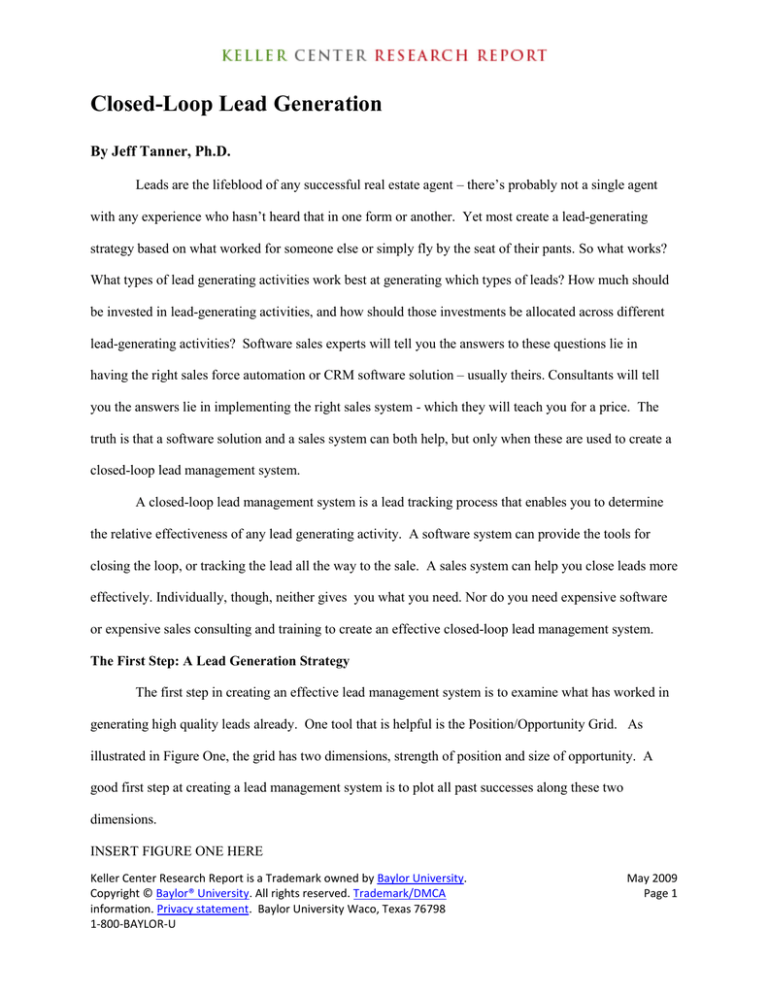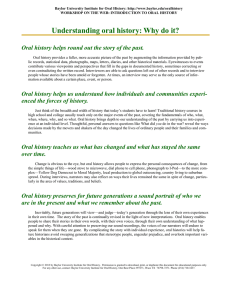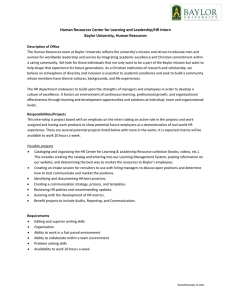
Closed-Loop Lead Generation
By Jeff Tanner, Ph.D.
Leads are the lifeblood of any successful real estate agent – there’s probably not a single agent
with any experience who hasn’t heard that in one form or another. Yet most create a lead-generating
strategy based on what worked for someone else or simply fly by the seat of their pants. So what works?
What types of lead generating activities work best at generating which types of leads? How much should
be invested in lead-generating activities, and how should those investments be allocated across different
lead-generating activities? Software sales experts will tell you the answers to these questions lie in
having the right sales force automation or CRM software solution – usually theirs. Consultants will tell
you the answers lie in implementing the right sales system - which they will teach you for a price. The
truth is that a software solution and a sales system can both help, but only when these are used to create a
closed-loop lead management system.
A closed-loop lead management system is a lead tracking process that enables you to determine
the relative effectiveness of any lead generating activity. A software system can provide the tools for
closing the loop, or tracking the lead all the way to the sale. A sales system can help you close leads more
effectively. Individually, though, neither gives you what you need. Nor do you need expensive software
or expensive sales consulting and training to create an effective closed-loop lead management system.
The First Step: A Lead Generation Strategy
The first step in creating an effective lead management system is to examine what has worked in
generating high quality leads already. One tool that is helpful is the Position/Opportunity Grid. As
illustrated in Figure One, the grid has two dimensions, strength of position and size of opportunity. A
good first step at creating a lead management system is to plot all past successes along these two
dimensions.
INSERT FIGURE ONE HERE
Keller Center Research Report is a Trademark owned by Baylor University.
Copyright © Baylor® University. All rights reserved. Trademark/DMCA
information. Privacy statement. Baylor University Waco, Texas 76798
1-800-BAYLOR-U
May 2009
Page 1
When considering strength of position, evaluate whether you offer any competitive advantages
for each individual buyer. These might include high familiarity with
a particular area or type of property, strength in understanding a
particular form of financing and relationships with lenders, strong
referral network in that market segment, and other personal
strengths that you brought to that sale. For opportunity, size of the
sale is obviously important. Also important, though, are such
elements as the client’s ability to provide leads or influence others,
whether the client is upwardly mobile (likely to trade up), stable, or
near empty-nest (likely to trade down), and other factors that might
influence that buyer’s value to you over time.
As you plot each of these on the grid, identify the source of each client. Was it a referral,
generated by an ad, identified at an event, or simply someone who happened to call the office on the right
day? Then, when this exercise is complete, do the entire exercise again but for clients that either didn’t
pan out or were lost to competition. Compare your lists and determine if there are lead sources that are
more likely to generate high-value clients than others.
From this analysis, you can create a strategy based on what has worked for you already. Further,
as you are faced with new lead generating opportunities, you will be more
prepared to evaluate those opportunities and make informed decisions
about where to invest your time, effort, and cash.
Closing the Loop
All leads are not created equal. As activities generate leads, a
good habit to have is to score the leads. Many agents will score a lead
based on urgency – will this lead buy or list now, soon, or sometime in the
Keller Center Research Report is a Trademark owned by Baylor University.
Copyright © Baylor® University. All rights reserved. Trademark/DMCA
information. Privacy statement. Baylor University Waco, Texas 76798
1-800-BAYLOR-U
May 2009
Page 2
far-off future? Now is considered a hot lead, soon a warm lead, and sometime a cold lead. With your
Position/Opportunity Grid, however, you can also assess how this lead fits into your market strengths and
have a better understanding of the likelihood of closing the lead.
Closing the Loop is simply tracking the lead all the way to the sale, and plotting that sale on the
Position/Opportunity Grid. While closing the loop seems simple, what this activity does for your planning
purposes is incredibly powerful. Each agent’s market strengths are different. Each market has its own
subtle nuances and its own lead-generating possibilities. Closing the loop provides you with the
information you need to make informed decisions about how to invest in the activities that will generate
the most valuable business.
Source: Weitz, Barton A., Stephen B. Castleberry, and John F. Tanner Jr. (2009), Selling:
Building Partnerships, Burr Ridge: McGraw-Hill.
About the Author:
John F. (Jeff) Tanner Jr., Ph.D., Professor of Marketing, Baylor University
Associate Dean for Research at Baylor
Dr. Tanner received his Ph.D. in 1988 from the University of Georgia and joined the faculty at Baylor
University that same year. Prior to his career in academia, Dr. Tanner worked in sales and marketing for
Rockwell International and Xerox Corporation. He is an active consultant and speaker, having taught
executives in France, India, Australia, Canada, Mexico, Trinidad, and Colombia.
Dr. Tanner’s research regarding sales strategy has been published in numerous scientific journals,
including the Journal of Personal Selling & Sales Management, Psychological Bulletin, Journal of
Marketing, and the Journal of the Academy of Marketing Science. In addition to almost 70 scientific
research journal publications, he has authored or co-authored 13 books. His most recent book is Sales
Management: Shaping Future Leaders (Prentice-Hall 2009) and he is also co-author of the leading college
Keller Center Research Report is a Trademark owned by Baylor University.
Copyright © Baylor® University. All rights reserved. Trademark/DMCA
information. Privacy statement. Baylor University Waco, Texas 76798
1-800-BAYLOR-U
May 2009
Page 3
sales textbook, Selling: Building Partnerships (McGraw-Hill). Along with George Dudley, Dr. Tanner
published The Hard Truth about Soft Selling (Behavioral Science Research Press) for practicing sales
executives.
Keller Center Research Report is a Trademark owned by Baylor University.
Copyright © Baylor® University. All rights reserved. Trademark/DMCA
information. Privacy statement. Baylor University Waco, Texas 76798
1-800-BAYLOR-U
May 2009
Page 4




